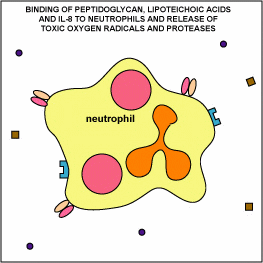Binding of Peptidoglycan and Lipoteichoic
Acids to Neutrophils and Extracellular Killing

The peptidoglycan
fragments and lipoteichoic acids released from the gram-positive cell wall bind
to toll-like receptors (TLRs) on the surface of defense cells such as monocytes,
macrophages and neutrophils. This is a normal component of body defense and
is one of the mechanisms by which the body is able to recognize that gram-positive
bacteria have invaded the body. The
binding of peptidoglycan fragments and lipoteichoic acids to their TLRs and
IL-8 to IL-8 receptors on the surface of neutrophils stimulates them to release
proteases and toxic oxygen radicals for extracellular killing.
Doc
Kaiser's Microbiology Home Page
Copyright ©
Gary E. Kaiser
All Rights Reserved
Updated: Oct. 12, 2005
Please send comments and inquiries to Dr.
Gary Kaiser
